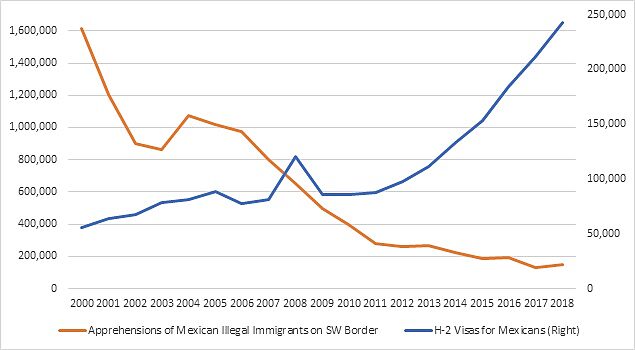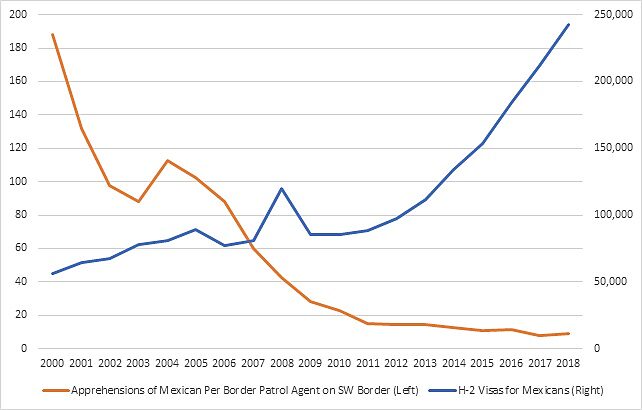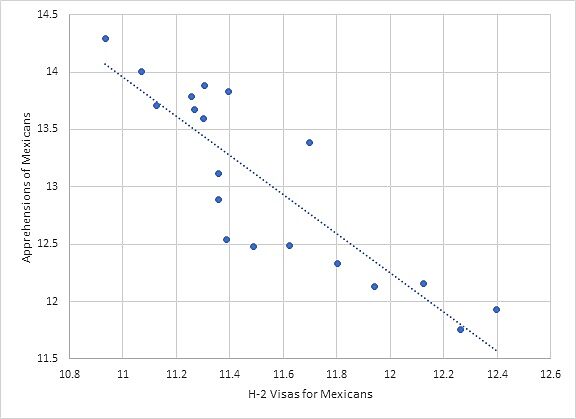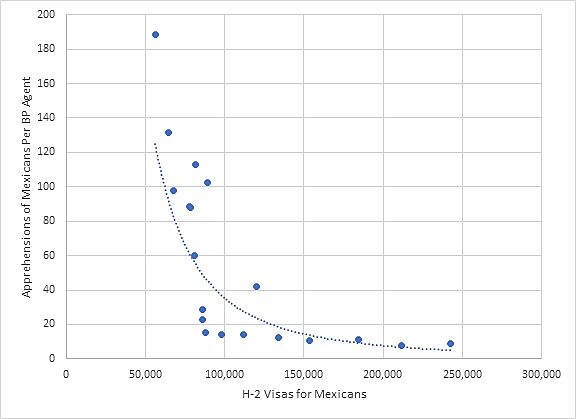Government data for the month of June show a substantial decrease in the number of immigrants apprehended along the Southwest border. Much of this decline is probably due to extra Mexican immigration enforcement prompted by President Trump’s threat of imposing tariffs on Mexican imports if they don’t reduce the surge of Central Americans from the Northern Triangle.
Lost in all of this debate over the Northern Triangle migrants arriving at the border is that fact that Mexican arrivals have collapsed in recent years. If we understand what caused the collapse in Mexican arrivals, then the government should apply that lesson to halt the flow of Northern Triangle illegal immigrants and asylum seekers. The vast increase in the number of H‑2 guest worker visas issued to Mexicans can explain a large percentage of the decrease in Mexican illegal immigrants. Increasing the numbers for Northern Triangle migrants will likely have a similar negative effect on their arrivals.
Figure 1 shows the tradeoff between the number of Mexicans apprehended on the Southwest border and the number of H‑2 visas issued to Mexicans from 2000–2018. There is a clear negative relationship between the two variables.
Figure 1
Apprehensions of Mexicans on the Southwest Border and H‑2 Visas Issued to Mexicans
Source: U.S. Department of State and U.S. Border Patrol.
Figure 2 is similar, but instead shows the number of Mexican apprehensions per Border Patrol agent and the number of H‑2 visas issued to Mexicans. Figures 1 and 2 are very similar, but the drop off in Mexican apprehensions is a little faster when the number of Border Patrol agents is controlled for in Figure 2.
Figure 2
Apprehensions of Mexicans Per Border Patrol Agent on the Southwest Border and H‑2 Visas Issued to Mexicans
Source: U.S. Department of State and U.S. Border Patrol.
Figures 3 and 4 show the strong negative relationship between the number of Mexican apprehensions and the number of H‑2 visas issued to Mexicans, where the latter figure controls for the number of Border Patrol agents and the former does not.
Figure 3
Apprehensions of Mexicans on the Southwest Border and H‑2 Visas Issued to Mexicans
Source: U.S. Department of State and U.S. Border Patrol.
Figure 4
Apprehensions of Mexicans Per Border Patrol Agent on the Southwest Border and H‑2 Visas Issued to Mexicans
Source: U.S. Department of State and U.S. Border Patrol.
Table 1 are the results of a regression where the dependent variable is the number of Mexicans apprehended on the Southwest border and the independent variables are the number of H‑2 visas issued to Mexicans and the number of Border Patrol agents per year, all logged. Independent variables are those that seek to explain variation in the dependent variable, so we are trying to see if changes in the number of apprehensions is correlated with changes in the number of H‑2 visas and Border Patrol agents. Since we expect serial correlation to be an issue in these time series, we ran Breusch-Godfrey tests for serial correlation for each model. In both cases we find evidence for serial correlation in the regression residuals, therefore we compute Newey-West standard errors as a correction.
From 2000–2018, a 1 percent increase in the number of H‑2 visas for Mexicans is associated with a 1.04 percent decline in the number of Mexicans apprehended on average. At the same time, a 1 percent increase in the number of Border Patrol agents is correlated with a 1.4 percent decline in the number of Mexicans apprehensions. If there is a causal relationship between the increase in the number of Border Patrol agents and decline in apprehensions, it is due to deterrence. Both findings are significant at the 1 percent level. These are both consistent with other findings, but it’s important to note that the median starting salary for a Border Patrol agent is $55,863, they take about a year to train, and private firms are having a difficult time hiring more when the unemployment rate is so low.
If the goal is to get control of the border by cutting illegal immigration, it is much simpler and cheaper to issue more H‑2 visas than to hire more Border Patrol agents. Since H‑2 visas increase economic production in the United States and Border Patrol agents decrease it by consuming taxpayer resources that would otherwise be used by the private sector, H‑2 visas have been a much more cost-effective way to cut Mexican illegal immigration than hiring more Border Patrol agents.
These results imply that, for the year 2018, an additional 2,426 H‑2 visas issued to Mexicans would have cut the number of illegal Mexican immigrants apprehended by 1,584 – on average. The total cost to taxpayers of that would be zero, with an increase in total tax payments because the H‑2 workers would provide taxable goods and services in the United States. On the other hand, for the year 2018, these findings imply that hiring an additional 166 Border Patrol agents would have cut the number of Mexican apprehensions by 2,132 that year – at a total additional salary cost of $9,277,727 that year. American taxpayers can either pay $4,353 per additional Mexican apprehension in extra Border Patrol wages – which doesn’t include any of the other large costs of immigration enforcement – or decrease the numbers by issuing more H‑2 visas with a net-positive fiscal impact.
Table 1
Apprehensions of Mexicans on the Southwest Border and H‑2 Visas Issued to Mexicans
Table 2 is the same regression as described above, except the dependent variable is the logged number of Mexican apprehensions per Border Patrol agent and the only independent variable is the logged number of H‑2 visas for Mexicans. A 1 percent increase in the number of H‑2 visas for Mexicans cuts the number of apprehensions per border patrol agent by 2.2 percent. These regressions are all significant at the 1 percent level. We also ran the regressions for Tables 1 and 2 that included the U.S. unemployment rate as a control variable, but it didn’t have much of an effect.
Table 2
Apprehensions of Mexicans Per Border Patrol Agent on the Southwest Border and H‑2 Visas Issued to Mexicans
For those who think that the Northern Triangle migrants apprehended on the Southwest border are asylum seekers, these findings will be largely irrelevant. If people are coming because their lives are threatened, then an expansion of H‑2 visas for them won’t have much of an effect on the number of asylum seekers arriving at the border. If, on the other hand, you believe that the flow of people from the Northern Triangle is largely driven by economics, then you should support a vast increase in the number of H‑2 visas for workers from the Northern Triangle – just like David North from the Center for Immigration Studies does.
Importantly though, the government should not increase the number of H‑2 visas for those from the Northern Triangle by decreasing those available to Mexicans. That would only increase Mexican illegal immigration.
More H‑2 visas for Mexicans cheaply and effectively cut the number of illegal Mexican immigrants coming over the border without the large and recurring taxpayer cost of hiring more Border Patrol agents. The government should at least try to expand the number of H‑2 visas to workers from the Northern Triangle, perhaps by exempting them from the H‑2B numerical cap, before taking further costly actions to increase border security.






